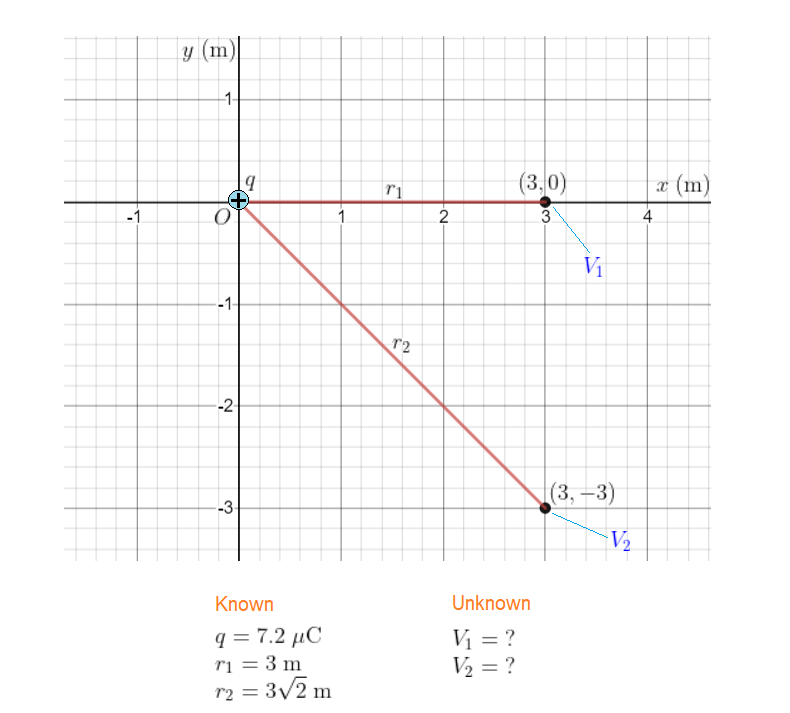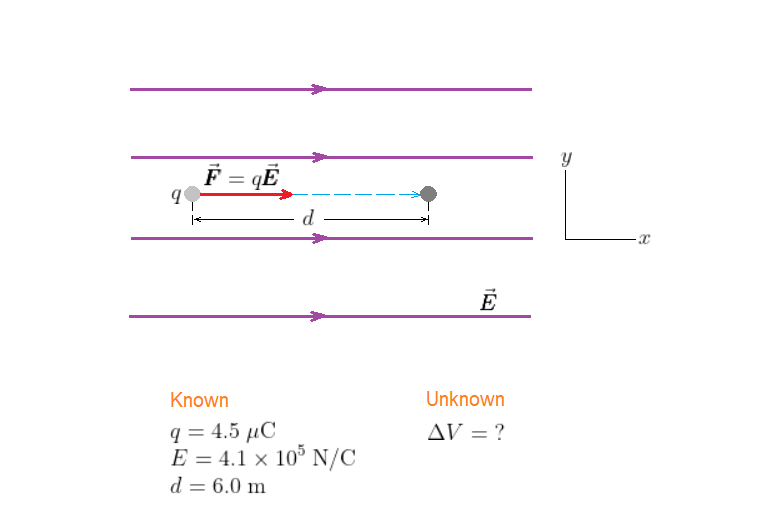
All Solutions
Page 727: Lesson Check
The situation is shown in our sketch, with the given charge and points of interest at their appropriate locations. The charge $q;(=7.2;mu$C) located at the origin is separated by a distance $r_1$ from the point (3.0,0) and a distance $r_2$ from the point $(3.0,-3.0)$. We call the electric potential due to $q$ at $r_1$ $V_1$ and at $r_2$ $V_2$.
$text{color{#4257b2}Strategy}$
The electric potential due to the charge $q$ can be found using $V = kq/r$, with $r = r_1$ for the location (3.0,0) and $r = r_2$ for the location $(3.0,-3.0)$.
$text{color{#4257b2}Solution}$
$textbf{(a)}$ Applying $V_1 = kq/r_1$, with $q = 7.2;mu$C and $r_1 = 3.0$ m, we find
$$
V_1 = (8.99times10^9;mathrm{N}cdotmathrm{m}^2/mathrm{C}^2)timesfrac{7.2times10^{-6};mathrm{C}}{3.0;mathrm{m}} = 2.2times10^4;mathrm{V}
$$
$textbf{(b)}$ Applying $V_2 = kq/r_2$, with $q = 7.2;mu$C and $r_2 = 3sqrt{2}$ m = 4.2 m, we find
$$
V_2 = (8.99times10^9;mathrm{N}cdotmathrm{m}^2/mathrm{C}^2)timesfrac{7.2times10^{-6};mathrm{C}}{4.2;mathrm{m}} = 1.5times10^4;mathrm{V}
$$

The situation is shown in our sketch. The 4.5-$mu$C charge, denoted by $q$, moves in a region of uniform electric field, which we call $vec{pmb E}$. The charge moves a distance $d = 6.0$ m in the positive $x$ direction.
$text{color{#4257b2}Strategy}$
As the charge $q$ moves in the direction of the electric field, $vec{pmb E}$, the electric potential, $V$, decreases. In particular, if the charge moves a distance $d$, the electric potential decreases by the amount $Delta V = -Ed$. Then the change in electric potential energy of $q$ is found using $Delta PE = qDelta V$.
$text{color{#4257b2}Solution}$
The change in electric potential is
$$
Delta V = -Ed = (4.1times10^5;mathrm{N/C})(6.0;mathrm{m}) = -2.5times10^6;mathrm{V}
$$
Hence, the change in electric potential energy of the charge $q$ is
$$
Delta PE = qDelta V = (4.5times10^{-6};mathrm{C})(-2.5times10^6;mathrm{V}) = -11;mathrm{J}
$$

$E=100$ V/m
$dl=169$ m
Solution:
Potential difference $V$ is given by
$$
V=Edl=left(100 {rm V/m}right)left(169 {rm m}right)=1.69times10^{4} {rm V}
$$
1.69times10^{4} {rm V}
$$
$$
q_{1}=+7.22 {rm mu C}=+7.22times10^{-6} {rm C}
$$
$$
q_{2}=-26.1 {rm mu C}=-26.1times10^{-6} {rm C}
$$
Electrostatic potential energy $U=-126$ J.
Solution:
The electrostatic potential energy is given by
$$
U=kfrac{q_{1}q_{2}}{r}
$$
or
$$
r=kfrac{q_{1}q_{2}}{U}=left(8.99times10^{9} {rm Nm^{2}/C^{2}}right)frac{left(+7.22times10^{-6} {rm C}right)left(-26.1times10^{-6} {rm C}right)}{left(-126 {rm J}right)}=1.34times10^{-2} {rm m}
$$
Haven't found what you were looking for?
Search for samples, answers to your questions and flashcards

